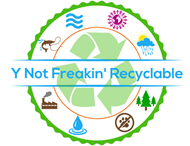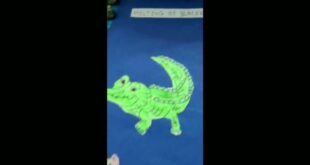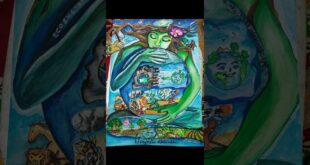[ad_1]
We are living in a time unlike any other. The rhythm of life is shifting; the frenzied speeds of daily activities and the productive flows that propel and accelerate entire societies have been intercepted by the global reach of the deadly coronavirus pandemic.
I write from Toronto, Canada, where this has been no exception. This indefinite slowdown has precipitated a pause that impresses upon us the urgency to consider how it is that we got here and how we want to move forward.
This pandemic has awakened within us the growing recognition that our immediately embodied ecologies are inextricably intertwined with the vitality of other planetary lifeforms and their diverse ecosystems. Certainly, this new coronavirus has emerged from destructive human violations of that profound connection. Our interdependence with earthly life must be appreciated if we are to avoid such further calamities.
Renunciation
Periods of disorientation inadvertently have the capacity to afford us new perspectives. As daily life is in suspense, an unprecedented positionality arises from which to consider two diverging actualities: on the one hand, the mechanisms by which our dominant way of life has perpetuated exploitation at the expense of nature, and on the other, the world that remains.
Of course, it is not as though the latter has laid concealed. We have been told for decades that we are living in the age of the Anthropocene. We function under the falsity that we have overcome nature, that we have transcended it and can separate ourselves from the plethora of lower organisms with which we share this earthly abode.
Such myopia has allowed us to persist so far. It has enabled us to live by ideational, technological, scientific, economic, and cultural systems that disregard the fundamental reciprocal flows and dynamisms of nature.
Significantly, the feasibility of such powerfully ingrained systems, which have hitherto provided assuredness, order, and sense of meaning, is not presently endangered by some epistemic shift nor monumental human action. It is endangered by a virus that makes visible our corporeal binding with other organisms on the most elementary level.
In a recently published article Franco “Bifo” Berardi has, by way of Donna Harraway’s work, pointed out that “the Earth is rebelling against the world, and the agents of planet Earth are floods, fires, and most of all critters.” Our entrenched renunciation of nature is certainly backfiring.
Reciprocity
We still believe nature to be an inert mechanism, something that we manipulate, direct, control, and form in our image; something that we act on but are not acted on by. But nature is intimately us, it is an animate, ever generative, and self-differentiating open field of relationships, interactions, unforeseen mixtures, among coexisting and mutually informing beings.
What will have become more evident during this pandemic is the unbreakable, undisputable, linkage of interdependence with our others, creaturely life different from, but not altogether unlike us. We cannot willfully extricate ourselves from the so-called natural world, despite the push to the contrary.
Nothing of who we are, have been, or are in the process of becoming has come to be apart from nature. Even our memory, that faculty precious to consciousness that we believe renders us the intelligent animal above other life, has been identified as a hundreds of millions of years old mutation attributed to a virus-mammal collaboration.
Nature is life weaving itself by reciprocal determination or co-constitutive actions, the future ramifications of which we do not yet and cannot altogether grasp.
It is unsurprising that our reckless actions in the epoch of the Anthropocene have this reciprocal effect of bringing our way of life to a halt.
Exploitation
The elimination of ecosystems and biodiversity poses dangerous risks to planetary health, and human wellbeing is intertwined with the health, vitality, and preservation of animal life. Viruses like Sars-CoV-2 do not uphold taxonomic classifications and distinctions, and are instead interspecies parasites that replicate in the human flesh.
Scientist Christine Johnson has stated that the levelling of natural habitats and the “exploitation of wildlife, which has caused once abundant wildlife to decline in numbers, […] have endangered species survival and put humans at risk of emerging infectious disease.”
This finding is echoed by others, including Felicia Keesing, a professor of biology at Bard College, who has emphasized that when we place pressure on ecosystems and “erode biodiversity, we see a proliferation of the species most likely to transmit new diseases to us.”
Of course, such destruction is a key component in the wider animal-industrial complex, as animal agriculture is itself one of the greatest threats to wildlife and a producer of climate change.
Though it is the case that such infectious zoonotic viruses are not a new phenomenon, the jump in the frequency of transmissions is attributed to human encroachments. We are likely to see a growing number of unknown viruses emerge as human activity continues to disturb the biome.
Destruction
Rather than provoking aversion to the intricate comminglings of the natural world, however, we are being challenged to revise the very principle of our engagement.
Richard Ostfeld notes that “there’s misapprehension among scientists and the public that natural ecosystems are the source of threats to ourselves. It’s a mistake. Nature poses threats, it is true, but it’s human activities that do the real damage. The health risks in a natural environment can be made much worse when we interfere with it.”
Surely, there is not only the one destructive pathway to interspecies engagement. We may choose to create another story by responding to this invitation. We can perceive during this tragic pandemic an unprecedented possibility to transform our planetary life.
Existence is affronted in multiple ways: the burning of the Amazon and substantial parts of Australia; the elimination of phytoplankton; the enormous plastic gyres forming in our oceans; undrinkable water in Indigenous communities in Canada; environmental refugees in places already stricken by poverty; daily extinction of between 150–200 irreplaceable species of animals; the loss of plant life, and the more than 200 million animals globally dismally killed for food each day.
The bodily integrity and livelihoods of vulnerable others has been long compromised due to unbound capitalist exploitation. As this pandemic grants us another look, we see that the persisting power disparities among bodies and ways of life are ever more visible.
Embodied ecologies
During this pandemic we are awakening to an unsettling actuality, one that cannot be, as before, set aside, ignored, nor dismissed. Instead, this call of nature presses itself on our bodies; this call is felt, it shapes actions, it determines movements, sensations, and relations.
Places once navigated with delight, annoyance, boredom, indifference, are lately unable to support human flows, as physical closeness and touch present danger. Many cities and landscapes have become emptied, absented, estranged uninhabitable places.
Almost overnight, this pandemic has led to an indefinite suspension of the collective performance of our ways of living. Places we habitually navigate, those we’ve worked at, socialized in, played in, and learned at, are abandoned shells, as it is uncertain they can safely accommodate us.
These places now rouse unease, discomfort and wariness, as though we are repelled by our own manmade infrastructure, architecture, artifacts. As though they cannot be sustained by our embodied presence and activities, nor sustain us.
Our way of organizing the social world at the expense of the natural world has threatened the bodily integrity of animal life and has transpired into a demand for social distancing, isolation, lack of contact and delimited movement.
Fear
But ongoing lockdown exposes us to other risks. As I share words online with friends and family – for some of us, the only present source of human interaction – I am made further aware of the harshness of constraints to bodily movement. This suspension and slowdown of everyday life has a profound mirroring effect experienced by the body-mind.
We are operating under competing demands; accustomed to rev-up and persist, we are reaching forward toward a future when the pandemic will have ended, all the while experiencing indefinite slowdown. To be in suspense, to be suspended, is to be held in place with nowhere to go.
This is a psychosomatic actuality that registers in the muscles, bones, joints, nerves, and organs, as stress, depression, sadness, and a whole host of other negative moods. The body rebels from beneath the skin.
We’ve also in a short period come to experience hesitancy, apprehension and distrust toward our own environments. Handwashing, sanitization, disinfection, avoidance, masking, and the physical distancing that we perform daily demonstrate to use that our bodies and abodes can host a compromising agent. We are all possible carriers.
This fear can become embedded in flesh, bones, movements and the deep crevices of our psyches. An encounter involving unsafe touch, we gather, could mean possible transmission, contamination, and illness. We are living with the anxiety-inducing uncertainty of being in touch; that most intimate way that we sense, know, and are enfolded in a variety of ecologies.
Touch
Touch is the most fundamental animal sense through which we connect with others, express ourselves and navigate the social world. Through physical isolation and separation, the risk is that touch can become invested with psychosomatic fear and anxiety. These negative bodily ecologies are impressed through the skin, reinforcing evermore self-isolation, seclusion, loneliness, and the inability to interconnect.
The psychosomatic effects of this pandemic will be carried in our bodies, and will define our relationships with ourselves, others, and the Earth. But we do indeed have means and methods to rise above. In this time of social and physical distancing, it is of even greater importance that we strengthen community and collectives, that we connect with friends and family, find moments of joy, and explore what lends us balance.
Though we cannot physically touch many surfaces, we can dip our hands in dirt to plant a seasonal garden, gaze at sparkling lights illuminated in moving waters, listen to the compositions of communing birds in nearby bushes, feel the gush of air swim across our cheeks as we move across a pathway, and so on.
Nature still grants us an unparalleled and generous healing force, available to our senses. We are touched by that which is alive. Through a reverence of nature and intertwinement with the multiplicity of lifeforms, I see that I am always more than what I am alone.
Nature in all its ways offers itself to my animal senses, its plenitude never ceasing to course through my body, weaving it into all that there is more to experience, to appreciate, to love, to become.
Reorganisation
Government narratives obscure this call to nature. Among other things, we have been summoned to slay an invisible enemy, something of a Jabberwocky. Despite recent reports of a Sars-CoV-2 outbreak in one of Canada’s primary meat packing plants, I am yet to hear the Canadian government acknowledge that the pandemic has anything to do with the deplorable treatment of animals or widespread destruction of biodiversity and ecosystems.
Instead, the state has done what states do; it has sought at this time of unpredictable crisis to preserve and reaffirm its necessity. In North America, governments have militarized their discourse on the virus, as well as their response. This is partially because as cracks in the dominant way of organizing life begin to show, the state, lacking the capacity to adequately deal with the crisis, seeks to reassert itself through a widening of its use of power.
As we remain indoors with our screens as connective devises, we are undoubtedly giving way to a troubling technopolis granting unseen forms of social control to power.
With the halting of economies around the world, however, we are intuitively questioning our way of life, individually and collectively. Such existential angst and questioning about what lends our lives meaning, must be acknowledged so that we may reorganize our social relationships on more equitable basis, transform our engagement with the natural world and shift the ethics by which we live our daily lives.
During this suspension of normal life, we are noticing that unrestrained accumulation and capitalist acceleration is no longer the dominant story of the day. That, to the contrary, despite a desire to return to the way things were or to some new normal, our anthropocentric way of life has shown itself to be unsustainable.
Capitalism
As we find ourselves on uncertain ground, we may mourn, and might question how long this lockdown could possibly continue. We might continue in this way so long as we remain convinced that this pandemic is a mere suspension and not a transformation.
Franco “Bifo” Berardi has suggested that this global lockdown could “break capitalist dynamics in a way that may be irremediable, irreversible.”
Our money, he further writes, “is impotent now,” particularly as a means of dealing with the underlying problem plaguing the human condition. More specifically, capitalism founds itself on the devastating philosophical principle that has favored the few.
We are perhaps acclimatising ourselves to the contrary and touching on the fundamental wisdom that nature is not and cannot be ultimately appropriated; that our conception of ownership and property, the undisputed claims to living beings and ecosystems for our seeming benefit, has unfortunately led us astray.
As we are invited to listen to the call of nature, the offering stands to renegotiate our way of life; a way of life that perpetuates and sustains itself by working in tandem, symbiotically, with nature, not against it.
As we collectively begin to be stirred by this impulse, the expansive words written by poet and jazz musician Sun Ra in his The Immeasurable Equation propel us toward alternative imaginaries: “I have nothing. Nothing! How really is I am…. Nothing is mine. […] I have the treasure of nothing. All of it is mine.”
This Author
Dr. Sanja Dejanovic is based in Toronto, ON, Canada. She is an author, educator, and artist moved by the human-animal relationship. She holds a PhD from York University, a SSHRC Postdoctorate from Concordia University and Bard College, and training in sensorimotor psychotherapy.
Image: ePi.Longo, Flickr.
Source link
Y Not Freakin’ Recyclable Home
 Pollution Climate Change Holocene Deforestation Population Acidification Y Not Freakin' Recyclable
Pollution Climate Change Holocene Deforestation Population Acidification Y Not Freakin' Recyclable



